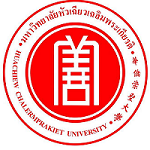Please use this identifier to cite or link to this item:
https://has.hcu.ac.th/jspui/handle/123456789/2425| Title: | การเปรียบเทียบประสิทธิภาพการกำจัดตะกั่วในน้ำเสียโดยใช้สารส้มและกัวกัม |
| Other Titles: | Efficiency Comparison of Lead Removal in Wastewater Using Alum and Guar Gum |
| Authors: | ยุวดี สีโส มาณิการ์ ผาสุก พรไพร ธรรมมาอ่อน อิสรี จิรจริยาเวช วรางคณา วิเศษมณี ลี Yuwasee Seeso Manika Phasuk Pornnprai Tummaon Isaree Jirajariyavech Varangkana Visesmanee Lee Huachiew Chalermprakiet University. Faculty of Public and Environmental Health. Undergraduate Student Huachiew Chalermprakiet University. Faculty of Public and Environmental Health. Undergraduate Student Huachiew Chalermprakiet University. Faculty of Public and Environmental Health. Undergraduate Student Huachiew Chalermprakiet University. Faculty of Public and Environmental Health Huachiew Chalermprakiet University. Faculty of Public and Environmental Health |
| Keywords: | น้ำเสีย -- การบำบัด -- การกำจัดตะกั่ว Sewage -- Purification -- Lead removal น้ำ -- การทำให้บริสุทธิ์ -- การรวมตะกอน Water -- Purification -- Coagulation การกำจัดน้ำเสีย Sewage disposal สารส้ม Alum กัวกัม Guar Gum |
| Issue Date: | 2019 |
| Abstract: | การวิจัยนี้มีวัตถุประสงค์เพื่อศึกษาปริมาณสารโคแอกกูแลนด์และค่าความเป็นกรด-ด่าง ที่เหมาะสมในการกำจัดตะกั่วในน้ำเสียโดยกระบวนการโคแอกกูเลชั่น-ฟล็อกกูเลชั่นด้วยสารส้มและสารส้มร่วมกับกัวกัมโดยใช้น้ำเสียสังเคราะห์ที่ความเข้มข้นของตะกั่วในน้ำเสียเริ่มต้นเท่ากับ 10 มิลลิกรัมต่อลิตร จากการศึกษาประสิทธิภาพการกำจัดตะกั่ว ที่ค่าความเป็นกรด-ด่างของน้ำเสียเริ่มต้นในช่วง 5-7 ปริมาณสารส้มในช่วง 100-1,000 มิลลิกรัมต่อลิตรและปริมาณกัวกัมในช่วง 0-10 มิลลิกรัมต่อลิตร ผลการศึกษาพบว่า ค่าความเป็นกรด-ด่าง 7 การใช้สารส้มปริมาณ 100 มิลลิกรัมต่อลิตร มีประสิทธิภาพการกำจัดตะกั่วเฉลี่ยสูงสุด คิดเป็นร้อยละ 97.59 เมื่อเปรียบเทียบความแตกต่างของการใช้สารส้ม และสารส้มร่วมกับกัวกัม โดยการวิเคราะห์ความแปรปรวนด้วยวิธี Duncan
พบว่าการใช้สารส้มเพียงชนิดเดียวจะมีประสิทธิภาพสูงสุด ซึ่งแตกต่างจากการใช้สารส้มร่วมกับกัวกัมอย่างมีนัยสำคัญทางสถิติ 95% ที่ระดับ P-value <0.05 สำหรับปัจจัยค่าความเป็นกรด-ด่างของน้ำเสียและปริมาณของสารส้ม พบว่า ไม่มีความสัมพันธ์กับประสิทธิภาพการกำจัดตะกั่วโดยมีค่า P-value 0.278 และ 0.470 ตามลำดับ The objective of this research was to determine the coagulant close and optimum pH of lead removal by coagulation-flocculation process using alum with guar gum. This study using synthetic wastewater containing lead concentration of 10 mg/L. The lead removal efficiency of wastewater was studied in the range of pH 5-7, alum dose 100-1,000 mg/L and guar gum dose 0-10 mg/L. The result from the batch experiment showed that the highest average of lead removal efficiency from wastewater were at pH 7 and alum dose 100 mg/L, the lead removal efficiency was 97.59%. The statistics of One-way ANOVA with Duncan use for the different of lead removal efficiency average for alum and alum with guar gum. The results of different of coagulant were statistically significant at 95% (p-value <0.05). The result showed that the only alum was highest efficiency. The factors of initial pH of wastewater and alum dose were not significant relationships with the efficiency of lead removal at the p-value 0.278 and 0.470, respectively. |
| Description: | Proceedings of the 7th National and International Conference on "Research to Serve Society", 12 July 2019 at Huachiew Chalermprakiet University, Bangphli District, Samutprakarn, Thailand. p. 1175-1182. |
| URI: | https://has.hcu.ac.th/jspui/handle/123456789/2425 |
| Appears in Collections: | Public and Environmental Health - Proceeding Document |
Files in This Item:
| File | Description | Size | Format | |
|---|---|---|---|---|
| Efficiency-Comparison-of-Lead-Removal.pdf | 2.48 MB | Adobe PDF | View/Open |
Items in DSpace are protected by copyright, with all rights reserved, unless otherwise indicated.
